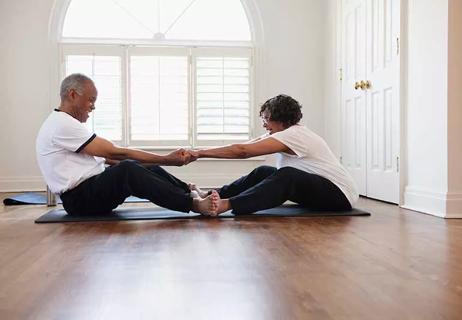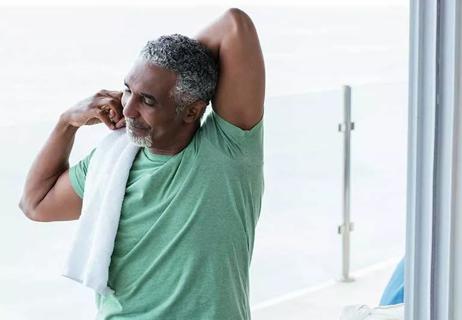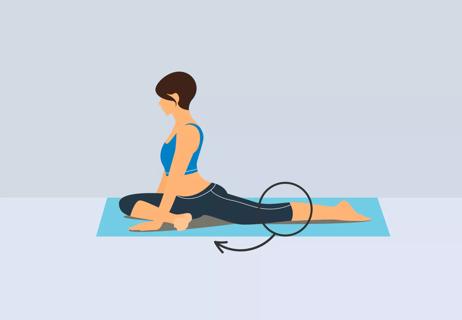Reduce pain and stiffness by stretching your body throughout the day

After sitting at your desk hunched over your computer all day, chances are you leave the office with some soreness or stiffness. You’re not alone. Research has shown that people who sit more than 75% of the day show an increased risk for neck and back pain, and poor health overall.
Advertisement
Cleveland Clinic is a non-profit academic medical center. Advertising on our site helps support our mission. We do not endorse non-Cleveland Clinic products or services. Policy
Chiropractor Chad Adams, DC, says moving your body throughout the day is key to relieving the aches and pains of office life. (The physical ones, at least! But these techniques may help with those challenging co-workers.)
Dr. Adams recommends a series of exercises known as CARs (short for “controlled articular rotations”). They’re stretches that isolate certain muscles, using slow, deliberate movements to increase flexibility.
“It’s important to move your body throughout the day at various times,” Dr. Adams says. “The goal should be to do a high volume of CARs motions throughout the entirety of your day, rather than performing them in one continuous set.”
Before getting started, Dr. Adams says to remember the key to a good stretch is to push it to the point of feeling the stretch. Back off if you feel any pain.
Sitting for the majority of your day puts a lot of pressure on both your back and neck. When we’re looking at our computer screens in front of our face, we don’t have much reason to look to the side, look up or down, or tilt our heads.
Exercises that encourage these movements can help relieve a stiff neck and increase your range of motion.
While standing or sitting, whichever is more comfortable, move your head in gentle circles.
Advertisement
Try to complete three circles per side or whatever feels good.
“You’ll want to avoid your shoulders lifting up or any turning of your body as you do this exercise,” Dr. Adams advises.
If it feels good, you can also try some neck rolls while contracting your neck muscles to add some resistance. Your muscles may shake some as you do this, which is normal as long as it doesn’t hurt.
Hunching your shoulders is a common, but harmful effect of sitting at a keyboard. Especially if your desk setup isn’t optimal for ergonomics.
Dr. Adams suggests keeping your arms at a 90-degree angle on your desk to help prevent overextension in your shoulders when typing or using a mouse.
Stand with your arms at your sides. Keep your elbow as straight as possible and the rest of your body as still as you can. The idea of this exercise is to move your shoulder blade in circles.
Your posture at your desk could be wreaking havoc on your back. Try adjusting your chair height so your feet touch the ground comfortably. One trick Dr. Adams suggests to check your posture is to ground your feet as if you were going to stand up, but remain seated, and hold for 10 to 15 seconds. This action automatically helps correct your posture: As your body prepares to rise, your head is in a neutral position with your spine.
Advertisement
It’s important to try to avoid a “fixed position” throughout the day, Dr. Adams says.
“Periodic stretching helps us maintain our flexibility throughout the day,” he continues. “For proper relief from tension, don’t count on ‘catching up’ on stretching at a later time.”
Take a quick break to get up and move or stretch after every 30 minutes of sitting. Taking time to do a series of 30-second stretch sessions multiple times throughout the day will ultimately help with holding poses for longer periods later.
If stretching daily isn’t doing the trick, it may be time to talk with a healthcare provider, like a primary care doctor or chiropractor, about the source of your pain and stiffness. They may be able to suggest exercises or other avenues to help relieve your discomfort.
Advertisement
Learn more about our editorial process.
Advertisement

This satisfying, involuntary act of yawning and stretching helps release tight muscles

While one focuses on stretching through movement, the other requires holding poses for 30 to 90 seconds — both can have a place in your fitness routine

Stretch before and after your workouts for maximum benefits, but your pre-workout stretches should be different from your post-workout stretches

Having a partner help you stretch can prevent injury and lead to an increased range of motion

Simply contracting certain muscles provides a good stretch to other areas of your body

Relax into this form of stretching while a prop or partner assists you

This extreme stretch can help build hip mobility and address pain in your back, knees and feet

Activities like swimming, cycling and rowing can get your heart pumping without stressing your joints

If you’re feeling short of breath, sleep can be tough — propping yourself up or sleeping on your side may help

If you fear the unknown or find yourself needing reassurance often, you may identify with this attachment style

If you’re looking to boost your gut health, it’s better to get fiber from whole foods